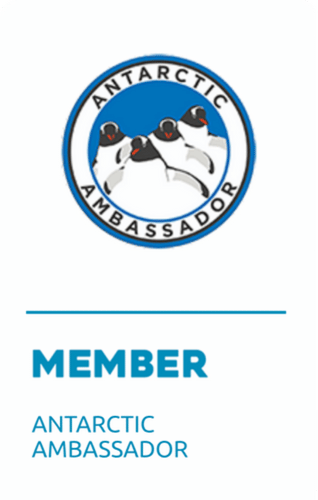CARL ANTON LARSEN (1860 – 1924)
 Carl Anton Larsen was a whaling pioneer, ship’s captain and inadvertent scientist. He is known for discovering the Larsen Ice Shelf and other features on the Graham Land Coast, as well as for the whaling station he built at Grytviken, South Georgia.
Carl Anton Larsen was a whaling pioneer, ship’s captain and inadvertent scientist. He is known for discovering the Larsen Ice Shelf and other features on the Graham Land Coast, as well as for the whaling station he built at Grytviken, South Georgia.
Early Life
Carl Anton Larsen was the son of a Norwegian Sea Captain. At the age of 9 he went to sea with his father, chasing seals and trading across the North Atlantic, only returning to go to school each year during the fall and winter. He learned about polar regions while serving with sealers along the eastern Greenland coast and was aboard the Jason during the famous voyage that carried Fridtjof Nansen to Greenland during his east-west crossing in 1888. Larsen passed his mate’s exam, became a Ship Master and bought a share of an old barque. Unable to find customers with freight to carry, he took up whaling off the coast of Norway.
First Norwegian expedition to Antarctica (1892-94)
Whale sightings by James Clark Ross and other explorers, brought whaling ships to Antarctic waters. Larsen, in command of the Jason, led a Norwegian whaling reconnaissance expedition from 1892-94. They spent the 1892-93 austral summer exploring the waters and shores of Graham Land (northern part of Antarctic Peninsula), returning the following summer to investigate the Weddell and Bellingshausen Seas. While they found no right whales, they did bring home seal skins and oil, as well as new scientific discoveries. Of all those who visited the Antarctic regions in search of whales, Larsen unquestionably brought home the best and most abundant scientific results. To him we owe the discovery of the Larsen Ice Shelf, the Foyn Coast in Graham Land, as well as King Oscar Land, and Robertson Island. He brought us news of two active volcanoes and many groups of islands. But perhaps the greatest interest attaches to the fossils he brought home from Seymour Island — the first to be obtained from the Antarctic regions.
Swedish Antarctic Expedition (1901-04)
From 1901-03, Larsen captained the ship Antarctic as part of the Swedish Antarctic Expedition, led by geologist Otto Nordenskjöld. Antarctic arrived in the South Shetlands in January 1902 and Nordenskjöld was put ashore with five others on Snow Hill Island to spend the winter. The ship then set sail to explore South Georgia, where they found a sheltered harbour, a supply of fresh water, and an abundance of whales. During their stay the expedition archeologist found numerous sealers’ artefacts and named the site Grytviken (‘Pot Cove’). Larsen saw the possibilities to establish a land-based whaling station. The following year, Larsen returned to the Antarctic Peninsula to retrieve the Nordenskjöld party, but the Antarctic was beset and destroyed by pack ice. Nordenskjöld and his companions, unaware of the fate that had befallen their vessel, resigned themselves to another winter when the ship failed to appear.
Larsen had put three men ashore at Hope Bay to search for Nordenskjöld, in case the ship was unable to penetrate the ice. When they found their way to Snow Hill Island blocked by open water, they returned to Hope Bay to wait. The Antarctic never came back to pick them up and they were forced to spend the winter of 1903 in dismal conditions. They built a makeshift stone and ice shelter and survived on meager supplies and penguin meat.
Meanwhile, after the ship was lost, the rest of the crew laboriously made their way over broken sea ice to Paulet Island for the winter. They too built a stone hut and survived on penguin and seal meat. On October 12, 1903, the Snow Hill and Hope Bay parties met near Vega Island, then both groups returned to Snow Hill Island. The Argentine ship Uruguay rescued everyone in November of 1903.
Land-based Whaling at South Georgia
When Larsen arrived in Buenos Aires in 1903 he came into contact with two leading businessmen who showed an interest in whaling and they founded “Company Argentine de Pesca”. Larsen settled on the island of South Georgia in 1904 and organized the construction of a whaling station at Grytviken, thus introducing a new era of shore-based whaling. The first oil was produced on Christmas Eve 1904 and within a few years the Antarctic was producing about 70% of the world’s oil, forcing the whales almost to extinction. Larsen died during the first attempts to run a full-scale whale factory ship down towards the Ross Sea in December, 1925.
Legacy
Altogether you will find 12 place names below the Convergence tied to this remarkable man. The feature that is perhaps best known is the Larsen Ice Shelf, along the east coast of Antarctic Peninsula in the northwest part of the Weddell Sea. In 2002 scientists watched in awe as Antarctica’s Larsen B Ice Shelf shattered almost completely in just six weeks. No one had ever seen such a large mass of ice vanish so quickly. Ice shelves are the gatekeepers for glaciers flowing from Antarctica toward the ocean. Without them, glacial ice enters the ocean faster and accelerates the pace of global sea level rise. The ongoing breakup of Larsen B is significant in its lesson that change in Antarctica can happen more quickly than scientists had previously thought possible and it shows what will happen to the huge glaciers farther south once their ice shelves break up to the point of no return.



